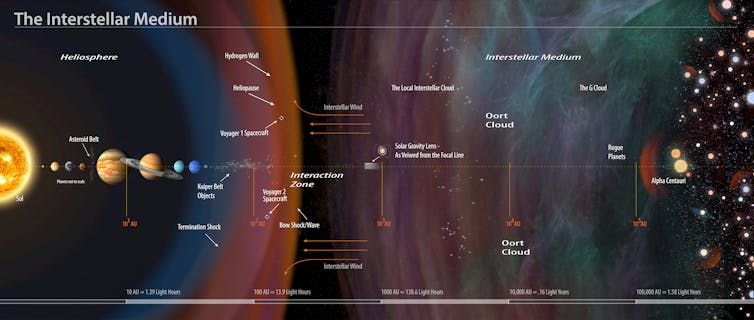The origin of life on Earth is still enigmatic, but we are slowly unraveling the steps involved and the materials needed. Scientists believe that life arose out of a primordial soup of organic chemicals and biomolecules on the early Earth that eventually led to true living organisms.
It has long been suspected that some of these materials may have been delivered from space. Now a new study, Published in Science Advances, showed that a special group of molecules called peptides can be formed much more easily under the conditions of space than those found on Earth. That means they could have been delivered to the early Earth by meteorites or comets — and life could have evolved elsewhere.
The functions of life in our cells (and all living things) are sustained by large, complex carbon-based (organic) molecules called proteins. How to make the different types of proteins we need to stay alive is encoded in our DNA, a large and complex organic molecule.
However, these complex molecules are assembled from a variety of smaller and simpler molecules such as amino acids – the so-called building blocks of life.
Explaining the origin of life requires understanding how and where these building blocks form and under what conditions they spontaneously assemble themselves into more complex structures. Finally we need to understand the hierarchy of transforming them into a finite, self-replicating system – a living organism.
This latest study sheds light on how some of these building blocks may have formed and assembled and how they ended up on Earth.
Steps for life
DNA 20 different amino acids. Like the letters of the alphabet, these are arranged in different combinations to encode our genetic code in the double helix structure of DNA.
Peptides are groups of amino acids in a chain-like structure. Peptides Composed of two amino acids, but can contain up to hundreds of amino acids.
Incorporating amino acids into peptides is an important step because peptides provide functions such as „catalyzing” or promoting reactions critical to survival. They are candidate molecules that may further assemble into early versions of membranes, regulating functional molecules in cell-like structures.
However, despite their important role in the origin of life, the spontaneous formation of peptides under environmental conditions on early Earth is not so straightforward. In fact, the scientists behind the current study shown earlier The cold conditions of space are actually very favorable for the formation of peptides.

At a very low density of molecules and dust particles in a region of space called the interstellar medium, single atoms of carbon stick to the surface of dust grains along with molecules of carbon monoxide and ammonia. They are Then form reaction Amino acid-like molecules. As such a cloud thickens and dust particles begin to stick together, these molecules assemble into peptides.
In their new study, the scientists look at the dense environment of dusty disks from which a new solar system with a star and planets will eventually emerge. Such disks form when clouds suddenly collapse under gravity. In this environment, water molecules are more abundant—forming ice on the surface of growing accumulations of particles that can block reactions that form peptides.
By mimicking the reactions that might occur in the stellar medium in the lab, the study showed that the formation of the peptides was slightly reduced, but not inhibited. Instead, as rocks and dust combine to form larger bodies such as asteroids and comets, these bodies heat up and allow fluids to form. This increases peptide formation in these fluids, and there is a natural selection of further reactions that result in more complex organic molecules. These processes would have occurred during the formation of our own solar system.
Many building blocks of life such as amino acids, lipids and sugars May develop in space environment. Many have been found in meteorites.
Peptide formation is more efficient in space than on Earth, and since they tend to accumulate in comets, their impacts on early Earth may have provided the stepping stones toward the origin of life on Earth.
What does all this mean for the chances of finding aliens? Well, the building blocks for life are available throughout the universe. How specific the conditions must be for them to self-assemble in living organisms is still an open question. Once we know that, we will have a better idea of how pervasive life is, or not.
Christian SchroederSenior Lecturer in Environmental Sciences and Planetary Studies, University of Stirling
This article has been republished Conversation Under Creative Commons License. Read on Original article.

„Oddany rozwiązywacz problemów. Przyjazny hipsterom praktykant bekonu. Miłośnik kawy. Nieuleczalny introwertyk. Student.
